Selenicereus Grandiflorus Profile
Written by Iris
Oct 09 2021
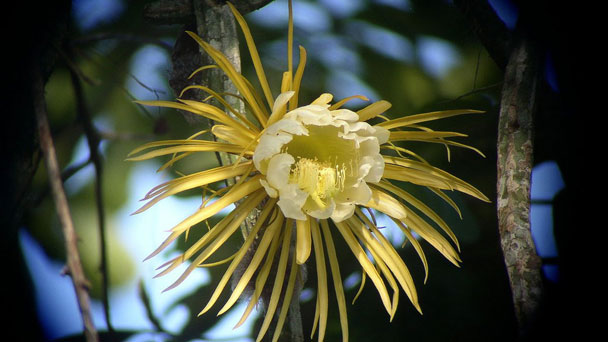
Selenicereus Grandiflorus is the cactus family. The genus includes more than 20 species of plants. Selenicereus Grandiflorus can grow on the ground as well as on rocks and trees. Selenicereus Grandiflorus lives in the forests and mountains of Central and South America. A distinguishing feature of Selenicereus Grandiflorus - very large flower, similar to lily. Some of them are 30 centimeters in diameter.
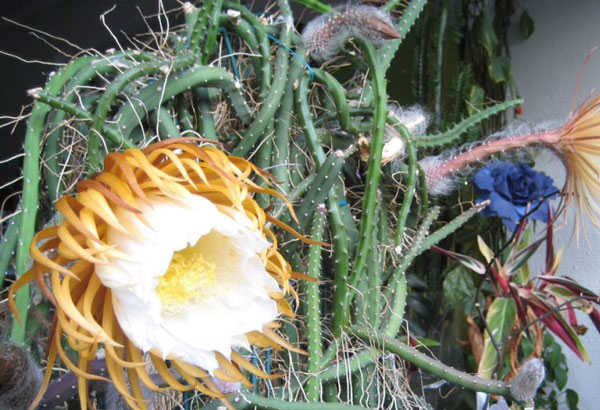
Another notable feature of this cactus — very large flowers similar to lilies. Some of them reach 30 cm in diameter. The scale of strikes and length of the tube of the Corolla: it exceeds the size of the flower. Colouring of inflorescences varied. The narrow outer part of the petals can be red, brownish or yellow tint. The inner part of the flower, usually painted in bright colors. Flowers selenicereus grandiflorus are formed long enough, and the buds at first look like a fluffy ball. But admire the beautiful colors of the plants will only be in the evening and night — by morning they have wilted. For this property cactus called the Princess or Queen of the night.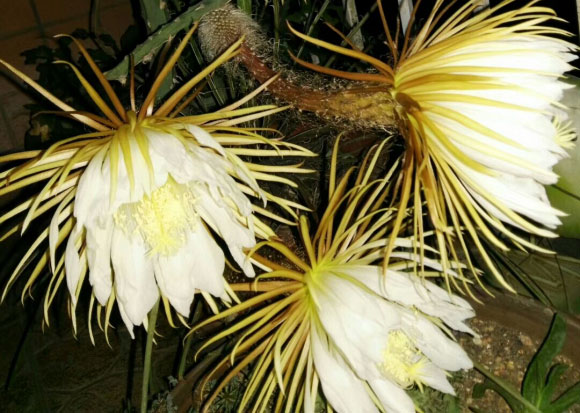
A feasible way to multiply Selenicereus Grandiflorus is by seeds, also in spring although it is possible in summer. These you have to sow them in seedbeds with holes, for example pots or planters, and with quality cactus soil (for sale here!). Place the Selenicereus Grandiflorus seeds on the surface, without crowding them, and spray them with water.
Propagation with Stem Cuttings
If you want to get new Selenicereus Grandiflorus copies, it is highly advisable to multiply it by stem cuttings. This is done in spring, simply cutting a piece from Selenicereus Grandiflorus, waiting about 7 days for the wound to dry well, and then planting it in a pot with a cheek bone for example. In about 10 days it will produce its first roots, but you must have it in that same container for at least a year, until it has rooted well.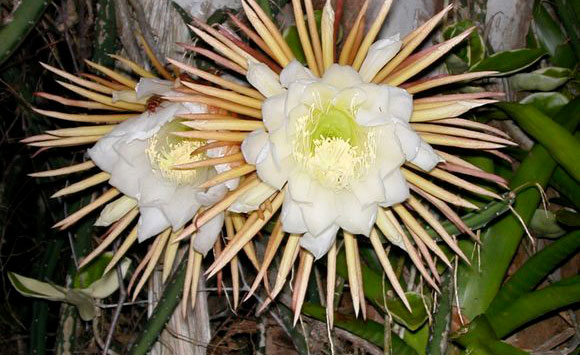
Selenicereus Grandiflorus is a plant that is designed to grow in the shadier parts of the jungle, which means that you will not want to give them too much direct sunlight, especially during the hottest part of the afternoon. They do need some sunlight, though, or the flowers will not be able to bloom properly. Soil Care
Land for Selenicereus Grandiflorus should be lightweight, breathable and fertile. Suitable soil that includes sand and turf. The mixture can also create your own, but the flower will satisfied with universal ground for cacti. Additionally, you can add a medium-sized expanded clay, gravel or brick fragments, and also crushed charcoal to prevent putrefactive processes. On the bottom of the tank is placed a thick layer of drainage.
Water Care
Selenicereus Grandiflorus, as a tropical plant, should be watered with lukewarm water. Rainwater is best, as tap water may contain fluoride and other minerals that can cause salt to build up in the soil. Distilled water may also be used. The soil should dry out between each watering. Watering should be reduced greatly at the start of fall, and the Selenicereus Grandiflorus plant placed in a cool, dark location so it can go dormant during the fall and winter (October through early March).
Temperature Care
In summer, the Selenicereus Grandiflorus cactus will suit the usual temperature of +18 degrees. It transfers heat quietly. In winter, when the plant has a rest period comes, you need to provide him with a reasonable cool — not above +17 degrees. The absence of such temperature changes can lead to a thinning of the stems. Selenicereus Grandiflorus can only from-for sharp changes of conditions or cold drafts. In this case, he can’t lose the ensuing buds.
Fertilizer Care
Selenicereus Grandiflorus has a rapid growth rate. To maintain the health of Selenicereus Grandiflorus plants need a constant flow of nutrients. During periods of active development is required to fertilize it almost every week — up to 3 times a month.
Pruning Care
Long stems of Selenicereus Grandiflorus can too grow and lose visual appeal. Separate the stems that spoil the appearance, you can prune. Small trimming (up to 3 stalks) will not affect the health of the plant, but a radical haircut is able to hurt him. To shape this cactus is similarly useless: remove a single escape will not lead to a rise in many side.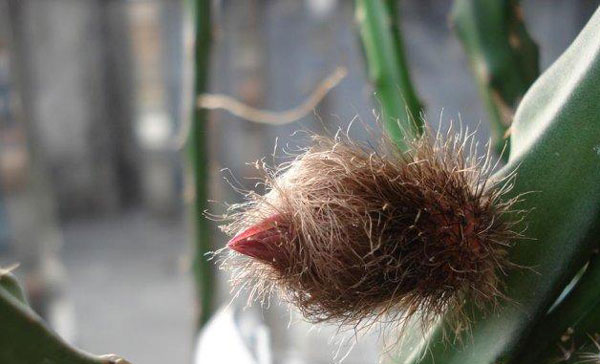
Selenicereus Grandiflorus has been used as a folkloric medicine in maintaining the symptoms of congestive heart failure and a heart tonic to regulate blood pressure.
Homeopathy Research:
According to a study published by the European Agency for Evaluation of Medicinal Products, dried or fresh overground parts of the Selenicereus Grandiflorus plant are utilized in traditional human phytotherapy.
Red Yellowy Edible Fruit:
As shown by the name, they bloom at night, or we can say they only bloom for a single night during the entire year.
Moreover, the flowers emit a vanilla fragrance that attracts nocturnal bats for pollination, making a red tomato-size fruit edible for humans.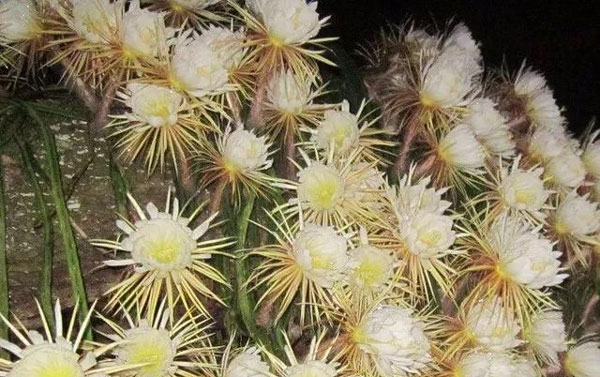
Selenicereus costaricensis: Also called the Costa Rican Pitahaya, this is grown commercially. It gives fruits called pitaya and beautiful flowers too. The vine is rather pretty and the species is very similar to Selenicereus monacanthus.
Selenicereus Grandiflorus: Also called night-blooming cereus, this species found a mention in Darwin's The Botanical Garden published in 1791. He describes the plant as parasitic, intoxicating and spooky. Darwin said that the plant was poisonous and back in the day, they were used to make poison arrows.
Selenicereus minutiflorus: This species is native to Honduras, Belize and Guatemala. When fully grown, it has three-angled stems that are 1.5 to 3.5 cm in diameter. The areola are about two to four cm apart and the plant has small brown-colored spins and sometimes also long spines.
Selenicereus pteranthus: Also called the princess of the night, this one is quite popular and blooms at night. It has four to six-angled stems with spines and no leaves. Some spins are conical and sometimes grow in clusters of two or four.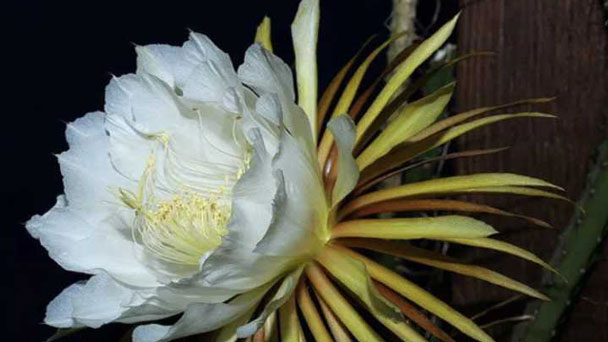
Selenicereus Grandiflorus PictureSelenicereus Grandiflorus InfoSelenicereus Grandiflorus Ecological HabitsSelenicereus Grandiflorus DistributionHow to Grow and Care for Selenicereus GrandiflorusHow to Grow Selenicereus GrandiflorusHow to Care for Selenicereus GrandiflorusUses of Selenicereus GrandiflorusVarieties of SelenicereusCommon Pests/DiseasesSelenicereus Grandiflorus Design Tips
Selenicereus Grandiflorus Picture

Selenicereus Grandiflorus Info
| Scientific Name | Selenicereus Grandiflorus |
| Common Name | Queen of the Night Cactus |
| Family: | Cactaceae |
| Genus: | Selenicereus |
| Species: | grandiflorus |
| Synonym: | Cereus grandiflorus |
Selenicereus Grandiflorus Ecological Habits
Selenicereus Grandiflorus different thin climbing stems about 12 m long, of which grow aerial roots. They cling to tree branches and other supports. Per year the selenicereus Grandiflorus plant can grow a couple of meters.Another notable feature of this cactus — very large flowers similar to lilies. Some of them reach 30 cm in diameter. The scale of strikes and length of the tube of the Corolla: it exceeds the size of the flower. Colouring of inflorescences varied. The narrow outer part of the petals can be red, brownish or yellow tint. The inner part of the flower, usually painted in bright colors. Flowers selenicereus grandiflorus are formed long enough, and the buds at first look like a fluffy ball. But admire the beautiful colors of the plants will only be in the evening and night — by morning they have wilted. For this property cactus called the Princess or Queen of the night.
Selenicereus Grandiflorus Distribution
The first cultivated species of Selenicereus grandiflorus is mentioned by Carl von Linne (Linnaeus) in 1753, where he described it as the largest flowered species of cacti known at the time. However, Selenicereus Grandiflorus was introduced to Europe well before this, with historical records at Hampton Court Gardens mentioning it growing there prior to 1700. Native to the Caribbean Islands and South America, Selenicereus Grandiflorus is an epiphyte, scrambling up trees and rocks, reaching for light. It has aerial roots and so does not look like the typical cactus as seen in Westerns.
How to Grow and Care for Selenicereus Grandiflorus
How to Grow Selenicereus Grandiflorus
Selenicereus Grandiflorus Propagation with SeedsA feasible way to multiply Selenicereus Grandiflorus is by seeds, also in spring although it is possible in summer. These you have to sow them in seedbeds with holes, for example pots or planters, and with quality cactus soil (for sale here!). Place the Selenicereus Grandiflorus seeds on the surface, without crowding them, and spray them with water.
Propagation with Stem Cuttings
If you want to get new Selenicereus Grandiflorus copies, it is highly advisable to multiply it by stem cuttings. This is done in spring, simply cutting a piece from Selenicereus Grandiflorus, waiting about 7 days for the wound to dry well, and then planting it in a pot with a cheek bone for example. In about 10 days it will produce its first roots, but you must have it in that same container for at least a year, until it has rooted well.

How to Care for Selenicereus Grandiflorus
Light CareSelenicereus Grandiflorus is a plant that is designed to grow in the shadier parts of the jungle, which means that you will not want to give them too much direct sunlight, especially during the hottest part of the afternoon. They do need some sunlight, though, or the flowers will not be able to bloom properly. Soil Care
Land for Selenicereus Grandiflorus should be lightweight, breathable and fertile. Suitable soil that includes sand and turf. The mixture can also create your own, but the flower will satisfied with universal ground for cacti. Additionally, you can add a medium-sized expanded clay, gravel or brick fragments, and also crushed charcoal to prevent putrefactive processes. On the bottom of the tank is placed a thick layer of drainage.
Water Care
Selenicereus Grandiflorus, as a tropical plant, should be watered with lukewarm water. Rainwater is best, as tap water may contain fluoride and other minerals that can cause salt to build up in the soil. Distilled water may also be used. The soil should dry out between each watering. Watering should be reduced greatly at the start of fall, and the Selenicereus Grandiflorus plant placed in a cool, dark location so it can go dormant during the fall and winter (October through early March).
Temperature Care
In summer, the Selenicereus Grandiflorus cactus will suit the usual temperature of +18 degrees. It transfers heat quietly. In winter, when the plant has a rest period comes, you need to provide him with a reasonable cool — not above +17 degrees. The absence of such temperature changes can lead to a thinning of the stems. Selenicereus Grandiflorus can only from-for sharp changes of conditions or cold drafts. In this case, he can’t lose the ensuing buds.
Fertilizer Care
Selenicereus Grandiflorus has a rapid growth rate. To maintain the health of Selenicereus Grandiflorus plants need a constant flow of nutrients. During periods of active development is required to fertilize it almost every week — up to 3 times a month.
Pruning Care
Long stems of Selenicereus Grandiflorus can too grow and lose visual appeal. Separate the stems that spoil the appearance, you can prune. Small trimming (up to 3 stalks) will not affect the health of the plant, but a radical haircut is able to hurt him. To shape this cactus is similarly useless: remove a single escape will not lead to a rise in many side.

Uses of Selenicereus Grandiflorus
Medicinal Uses:Selenicereus Grandiflorus has been used as a folkloric medicine in maintaining the symptoms of congestive heart failure and a heart tonic to regulate blood pressure.
Homeopathy Research:
According to a study published by the European Agency for Evaluation of Medicinal Products, dried or fresh overground parts of the Selenicereus Grandiflorus plant are utilized in traditional human phytotherapy.
Red Yellowy Edible Fruit:
As shown by the name, they bloom at night, or we can say they only bloom for a single night during the entire year.
Moreover, the flowers emit a vanilla fragrance that attracts nocturnal bats for pollination, making a red tomato-size fruit edible for humans.

Varieties of Selenicereus
Selenicereus anthonyanus: Also called fishbone cactus, it is a slow-growing type of tropical epiphytic cactus. They climb or hang up to 120 cm in length and are bright green in color with a zigzag shape.Selenicereus costaricensis: Also called the Costa Rican Pitahaya, this is grown commercially. It gives fruits called pitaya and beautiful flowers too. The vine is rather pretty and the species is very similar to Selenicereus monacanthus.
Selenicereus Grandiflorus: Also called night-blooming cereus, this species found a mention in Darwin's The Botanical Garden published in 1791. He describes the plant as parasitic, intoxicating and spooky. Darwin said that the plant was poisonous and back in the day, they were used to make poison arrows.
Selenicereus minutiflorus: This species is native to Honduras, Belize and Guatemala. When fully grown, it has three-angled stems that are 1.5 to 3.5 cm in diameter. The areola are about two to four cm apart and the plant has small brown-colored spins and sometimes also long spines.
Selenicereus pteranthus: Also called the princess of the night, this one is quite popular and blooms at night. It has four to six-angled stems with spines and no leaves. Some spins are conical and sometimes grow in clusters of two or four.

Common Pests/Diseases
Although, Selenicereus Grandiflorus is an easy-to-care-for plant just like Monstera Adansonii. Still, it is not immune to mealybugs, root rot, or other harmful insects. Here’s how you can protect your beautiful Selenicerues grandiflorus from all the pesky bugs before blooming: Use a mixture of water and soap or even a lacewing to shield the leaves from insects and maintain regular watering to prevent the plant from root-rot.Selenicereus Grandiflorus Design Tips
Selenicereus Grandiflorus can be grown as a houseplant with the key requirements being a minimum temperature of 5oC and a lot of space. A frame will be needed to support it and it needs to be positioned somewhere with good light, such as a large window, heated conservatory or heated glasshouse. In the wild these plants are subject to some shade as they grow under the canopy of their supporting tree until they grow out of the top into the sun. Lack of shade can make the young plants vulnerable to scorch.Latest Updated
- Benefits of Bugleweed - 7 Science-backed Health Benefits
- Bugleweed Dangers & Side Effects - Is It Poisonous?
- How to Plant Evergreen Trees - What You Should Know
- When to Plant Evergreens - Grow Guide for Evergreen Trees
- 12 Wonderful Evergreen Shrubs for Your Garden
- 12 Popular Evergreen Plants with Pictures for Beginners
- When And How To Prune A Lilac Bush Like a Pro
- How to Grow & Care for Lilac Vine (Hardenbergia Violacea)
- Japanese Lilac Tree (Syringa Reticulata) Care & Propagation Guide
- Shumard Oak Pros and Cons - What to Know
Popular Articles
- Winter maintenance of Antirrhinum Majus
- How to Grow Terminalia Mantaly Tree
- How to Grow and Care for Crossostephium Chinense
- How to grow Antirrhinum Majus in spring
- Peristeria Elata (Dove Orchid) Profile: Info & Care Guide
- Underwatered Snake Plant (Sansevieria Trifasciata) - Signs And How To Fix
- How to Care for Brazilian Jasmine Plant (Mandevilla Sanderi)
- How to Grow & Care for Graptopetalum Purple Delight in Summer
- Rosa Chinensis (China Rose): Plant Growing & Care Tips
- How to Care for Baby Sun Rose (Aptenia Cordifolia)